
PAWS OFF MY PRODUCE!
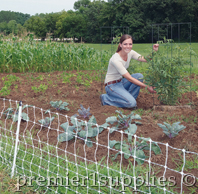
Keep the critters out!
Electrified netting, such as VersaNet and VersaNet Plus, is a practical deterrent to most low-clearance garden pests (not deer).
Want a quick decision? Choose from our netting & energizers kits.
Both buying and building fences can be complicated for those without experience. New users tell us that netting kits and energizer kits simplify purchasing decisions—because there are many netting options, support post choices, energizers, ground rods, etc.
We also know that:
| 1. |
Many already own an energizer. If you’re not sure whether it will work for our fences, call us at 800-282-6631 and ask. We'll be glad to help. |
| 2. |
Many need longer fences and larger energizers than suggested in our kits. If so, call one of our fence consultants at 800-282-6631 and we'll help you reach a solution. |
| 3. |
Sometimes seeing helps! So check out our “How-to” videos on our website to see how to install and take down netting. |
PREMIER ENERGIZERS
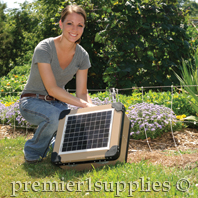
No outlet? No problem! PRS Solar units are powerful enough to power fences (RaccoonNet™ shown in photo) when a plug-in unit is not an option.
PRS Solar Energizers
Which unit is right for you?
The size, in pulse energy output (range from .5 joule to 2 joules), depends almost entirely on the weed contact that will occur and the length of the fence.
Contact Premier or call 800-282-6631 to speak with one of our fence consultants to help you determine the best energizer for your needs.
You can also view our energizer comparison charts online or in Premier's fencing catalog to help in choosing an energizer.
To get your PRS Solar Energizer ready for fencing season, view our how-to video.
For an easy way to see if your fence has at least 3000v running through it, check out our new BlitzLight!
HELPFUL ACCESSORIES
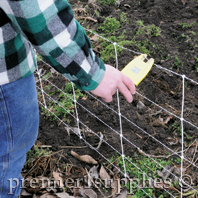
NEW!
Ez Digital Voltmeter
Self-grounding. No more hassles with a ground probe and its wires. Simply touch it to the fence and read the digital numbers. (4.3 = 4300 volts.)
View All of Premier's fence connectors and accessories.
|
 |
 |
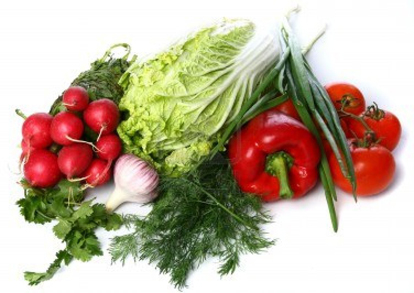
Decisions, Decisions: How to Choose the Right Vegetables for Your Garden
By Chris McLaughlin
For anyone planting a vegetable garden for the first time, perusing all those seed catalogs, garden center, and the internet just might have your head spinning. Where does one start?
The beauty of doing a little bit of planning before purchasing and planting is that you’re apt to choose those vegetable varieties that’ll thrive where they’re planted—and you’ll end up with a productive and successful vegetable garden.
Ask yourself some simple questions
I don’t want to get all stuffy on you by suggesting you need a strict plan, because you certainly don’t. That said, there’s a tremendous advantage to taking a little time to think about what you’d like to grow, where it will go, and how you would like to use it. The answers to these questions become a custom information base for you, which makes future garden plans and decision-making easier.
1. What is your family eating now? In order to get the most out of your veggie garden, you’ll need to make a list of every type of vegetable that you would purchase today from your grocery store’s produce section. These are the vegetables to grow in abundance.
Sit your entire your family down for just 15 minutes and make sure that you know what they like—then ask everyone what they’d enjoy growing that you don’t purchase regularly. Throw some new or fun options out there. This simple list-making task will save money and insure that your family actually eats the vegetables that you grow. Keep in mind that many crops don’t have to be used right away. Some can be stored for some months, such as potatoes, onions, and carrots.
2. (Basically) Understand your zone. Which part of your yard gets the most sun (full/6 to 8 hours)? The least? In-between? You should know at least this much before you start a garden bed. Most vegetables will need full sun, but there are exceptions such as lettuce, spinach, kale, peas, Swiss chard and many herbs that will tolerate shadier places.
Every location has a general “growing season” that you’ll need to factor in when choosing your vegetables. The determining factor of the length of your growing zone is the frost dates. Frost dates are the estimated last hard frost of spring and the first hard frost of fall or winter.
Your local cooperative extension office can give you some pretty precise dates as well as what’s currently going on in your growing corner of the world. Some years call for date changes and your extension office can alert you to these changes.
Nature being who she is, of course, these dates aren’t exact; they’re approximate. However, we can get pretty close to each area’s frost dates by averaging them as they’ve occurred throughout the years. The length of your season will not only affect which vegetable varieties you plant but also how many crops you’ll produce.
It’ll serve you well to not only figure out what vegetables you’d like to plant, but which varieties will grow well in your zone. The U.S. Department of Agriculture (USDA) provides a zone hardiness map as a general guideline for what will grow in each gardener’s particular area. It’s important to understand that these are very general guides. No map can guess the specific microclimate in your city, neighborhood or yard.
In fact, the USDA hardiness zone map is most helpful when discussing perennial plants, trees and shrubs. This is because any annual can be grown in any zone as long as there are enough warm days for that plant variety to reach harvest. Perennials need to be able to over-winter where they’re planted. So some argue that this map is irrelevant when planting vegetables. I disagree, I believe that knowing your growing zone is a helpful, general guide no matter what you’re planting.
Another general guide, which is even more helpful to you than the USDA map in the case of annual vegetables, is the American Horticultural Society’s (AHS) Plant Heat Zone Map. This guide is based on the average highs instead of the lows of plant survival. This map tells you the average number of days that temperatures are 86 degrees and above.
For instance, if you’re planting a vegetable (say a pumpkin variety) that requires 100 days of warm weather and your area has an average of 120 days of warmth or more, you’re in good shape. However, if you discover that you live in a growing zone that has only 60 warm days, you need to choose a variety that harvests closer to that amount of time.
3. Got microclimates? Microclimates are those areas within a larger general region that may have different climates than the whole. They can be created by a number of things such as physical structures, extra windy areas, topography or large bodies of water. For example, you may find that your zone is said to be prone to heavy frost, but become confused when your plants rarely succumb to an icy death.
Your zone might not act as it seems your zone should for many reasons. In urban areas, buildings (or lack thereof) can have a huge effect on the immediate area. They may act as wind barriers or create wind tunnels. If you have a large body of water nearby, such as a lake or the ocean, this tends to moderate the air temperatures of nearby inland areas.
Topography certainly plays a major role for microclimates. Do you live on a hill? Are you high up or deep down in a valley? Warm air is lighter than cold air, so if you live in a valley you may have more frost problems than someone living higher up.
On which side of the hill do you reside? A northern slope is slower to warm up, but a south-facing slope is a mixed bag. The southern side warms up faster, but if plants begin to bloom, they could be set back if a sudden frost hits.
Other factors that can affect microclimates are rainfall, soil types, mulching practices, paved surfaces, fences, walls, raised beds, cold frames, hoop houses, balconies and rooftops. So if you think that a number on a map has the last word on your garden, think again. Clever gardeners will manipulate their microclimate to their advantage.
4. How much space do you have—and need? This will depend upon which type of veggies you want to grow and how many. One thing is for sure, you absolutely do not need what usually is referred to as “land” to plant a vegetable garden. Not even close. Raised beds, trellises and containers go a long way in helping the modern homesteader produce crops year round.
There are successful ways to keep even sprawling veggies like pumpkins and other squash confined to a raised bed. One way would be to “train” the vines by physically aiming them in a direction and pruning them to keep only several vines. Another technique is to garden vertically; think up instead of out.
Some veggies take to containers with ease such as carrots, beans, peas, peppers, lettuce, etc. Tomatoes usually do well in containers, although if you let them dry out to the point where the soil pulls away from the sides of the container, they may never forgive you and are likely to produce less fruit.
5. Are you going to have help from family members? Think about how much you can feasibly do by yourself versus if you have backup from helping hands. Be honest with yourself, because vegetable plants are geared to produce—and when everything goes well, there can be a fair amount of work involved if you bite off more than you can chew (so to speak).
6. Still confused about which varieties to grow? You can get some big clues by checking out the plants available at your local garden center. What’s even better is to visit a nursery (not all garden centers are nurseries) where they’re actually growing the plants—the proof is in the pudding. Don’t forget to make use of the Master Gardeners at your local cooperative Extension Office.
Finally, don’t let any of these factors overwhelm you! Consider these questions the best that you can and it’ll soon become clear which vegetables are right for your family’s garden.
(Reprinted with permission From Scratch Magazine.)
SAVE THE SWEET CORN FROM RACCOONS
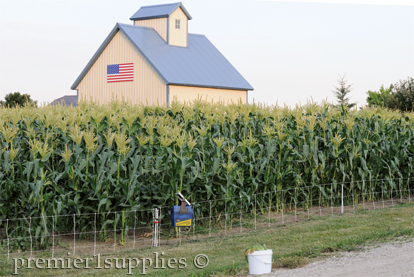
Raccoons are notorious for their addiction to sweet corn and other garden produce. They can destroy months of work in a single night and always seem to do so about a week before it’s ready for human consumption.
As sweet corn growers know, the best “raccoon-stopper” is an electric fence. Our RaccoonNet™ is unique because it’s a complete fence—all line posts are built into each roll.
Attach a suitable energizer—the net should always be properly energized.
RaccoonNet™ 4/18/12
| • |
Simple to install/remove |
| • |
Very effective in stopping raccoons |
| • |
Easy to step over
|
Want a quick choice?
Choose from our Netting kits & Energizer kits.
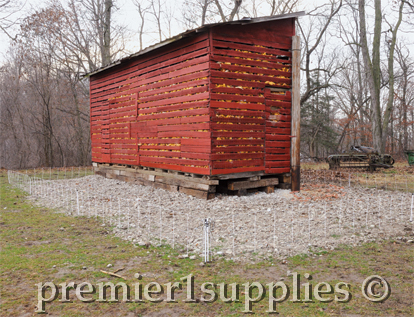
Yes, some folks still maintain and use their corn crib for its original purpose, storing ear corn. And raccoons have not lost their taste for ear corn. 1 to 2 rolls of RaccoonNet will fit around most cribs.
|
|